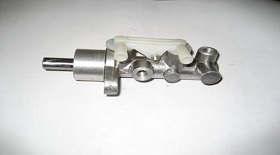The principle of brake system
The general principle of a brake system is to prevent the wheel from turning or turning by using the friction between the non-rotating elements connected to the body (or frame) and the rotating elements connected to the wheel (or transmission shaft).
The schematic diagram of a simple hydraulic braking system can be used to explain the working principle of the braking system. A metal brake drum with an inner circle as the working surface is fixed on the wheel hub and rotates with the wheel. On the fixed brake floor, there are two supporting pins supporting the lower end of the two arc brake shoes. The outer surface of the brake shoe is equipped with friction plates. The brake base plate is also equipped with a hydraulic brake wheel cylinder, which is connected with the hydraulic brake main cylinder mounted on the frame by tubing 5. The piston 3 in the master cylinder can be operated by the driver through the brake pedal mechanism.
When the driver stepped down the brake pedal, the piston compressed the brake fluid, the wheel cylinder piston in the hydraulic role of the brake shoe pressure to the brake drum, so that the brake drum reduces rotational speed or remains stationary.
When you know the brake system of a certain type of car, you may often hear the words "front disc rear drum" or "front disc rear drum". So what does it mean? Readers have emailed questions about car braking systems, such as the difference between disc brakes and drum brakes, the difference between ventilation discs and solid discs, and so on.
Welcome to the Mechanical parts Exhibition.



